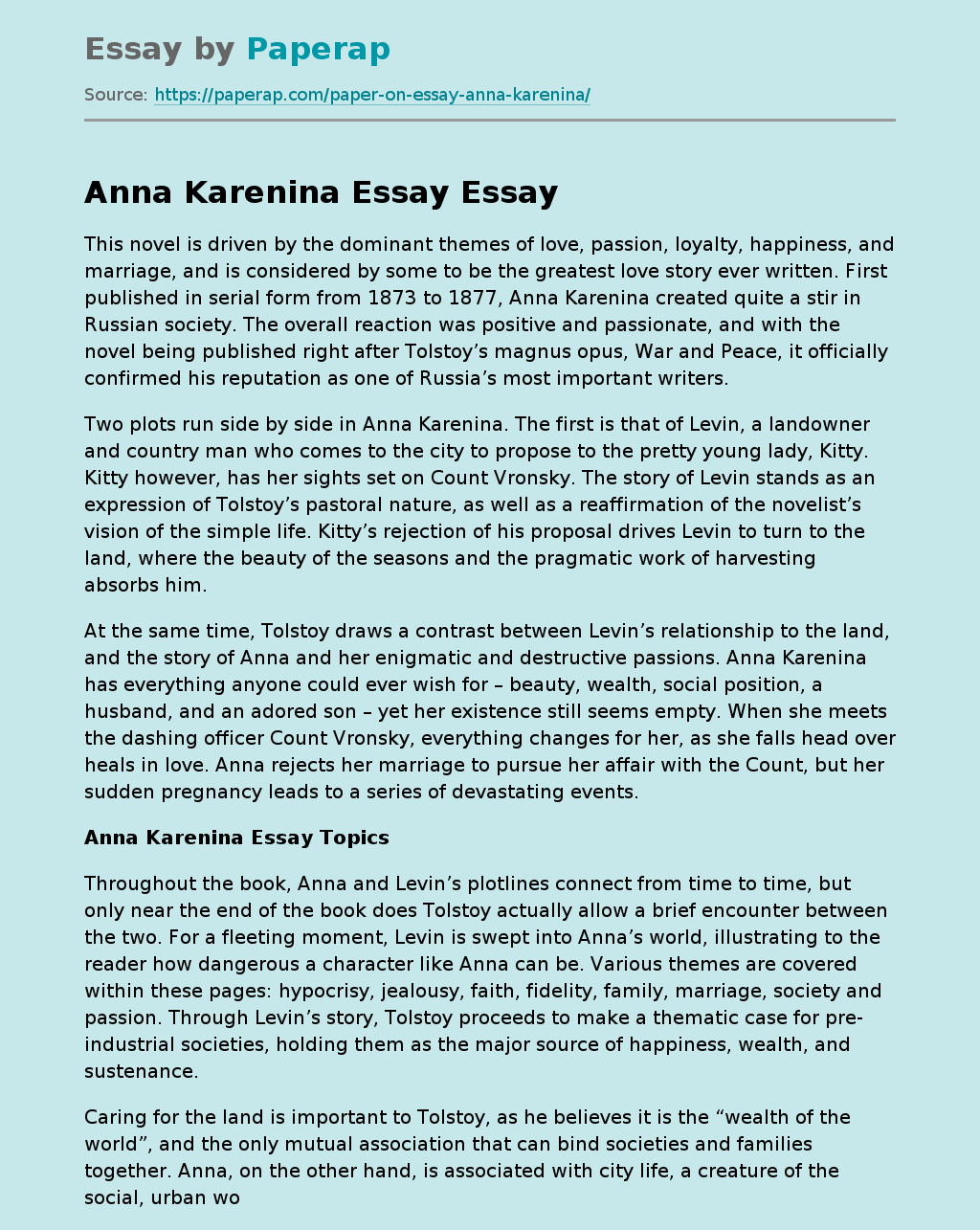Anna Karenina Essay
This novel is driven by the dominant themes of love, passion, loyalty, happiness, and marriage, and is considered by some to be the greatest love story ever written. First published in serial form from 1873 to 1877, Anna Karenina created quite a stir in Russian society. The overall reaction was positive and passionate, and with the novel being published right after Tolstoy’s magnus opus, War and Peace, it officially confirmed his reputation as one of Russia’s most important writers.
Two plots run side by side in Anna Karenina.
The first is that of Levin, a landowner and country man who comes to the city to propose to the pretty young lady, Kitty. Kitty however, has her sights set on Count Vronsky. The story of Levin stands as an expression of Tolstoy’s pastoral nature, as well as a reaffirmation of the novelist’s vision of the simple life. Kitty’s rejection of his proposal drives Levin to turn to the land, where the beauty of the seasons and the pragmatic work of harvesting absorbs him.
At the same time, Tolstoy draws a contrast between Levin’s relationship to the land, and the story of Anna and her enigmatic and destructive passions. Anna Karenina has everything anyone could ever wish for – beauty, wealth, social position, a husband, and an adored son – yet her existence still seems empty. When she meets the dashing officer Count Vronsky, everything changes for her, as she falls head over heals in love. Anna rejects her marriage to pursue her affair with the Count, but her sudden pregnancy leads to a series of devastating events.
Anna Karenina Essay Topics
Throughout the book, Anna and Levin’s plotlines connect from time to time, but only near the end of the book does Tolstoy actually allow a brief encounter between the two. For a fleeting moment, Levin is swept into Anna’s world, illustrating to the reader how dangerous a character like Anna can be. Various themes are covered within these pages: hypocrisy, jealousy, faith, fidelity, family, marriage, society and passion. Through Levin’s story, Tolstoy proceeds to make a thematic case for pre-industrial societies, holding them as the major source of happiness, wealth, and sustenance.
Caring for the land is important to Tolstoy, as he believes it is the “wealth of the world”, and the only mutual association that can bind societies and families together. Anna, on the other hand, is associated with city life, a creature of the social, urban world that revolves more around romance, sex, and societal affirmation than around virtue. A great deal of the spiritual underpinnings found in “Anna Karenina” are based on Tolstoy’s own life. Some critics even call this novel as a “spiritual autobiography”, referring to the religious crisis Tolstoy himself went through.
Surprisingly enough, despite the positive critical reaction to the book, Tolstoy was dissatisfied with it. Apparently he had a great deal of trouble writing it, as his religious crisis led him to be more interested in publishing didactic pamphlets and instructions than writing novels. To Tolstoy, Anna Karenina was mere “scribbling”. Nevertheless, tt remains, “an immortal drama of personal conflict and social scandal and a vivid, richly textured panorama of nineteenth-century Russia. “
Anna Karenina Essay. (2019, Dec 05). Retrieved from https://paperap.com/paper-on-essay-anna-karenina/

